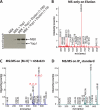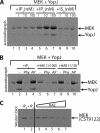The acetyltransferase activity of the bacterial toxin YopJ of Yersinia is activated by eukaryotic host cell inositol hexakisphosphate
- PMID: 20430892
- PMCID: PMC2888404
- DOI: 10.1074/jbc.M110.126581
The acetyltransferase activity of the bacterial toxin YopJ of Yersinia is activated by eukaryotic host cell inositol hexakisphosphate
Abstract
Plague, one of the most devastating diseases in human history, is caused by the bacterium Yersinia pestis. The bacteria use a syringe-like macromolecular assembly to secrete various toxins directly into the host cells they infect. One such Yersinia outer protein, YopJ, performs the task of dampening innate immune responses in the host by simultaneously inhibiting the MAPK and NFkappaB signaling pathways. YopJ catalyzes the transfer of acetyl groups to serine, threonine, and lysine residues on target proteins. Acetylation of serine and threonine residues prevents them from being phosphorylated thereby preventing the activation of signaling molecules on which they are located. In this study, we describe the requirement of a host-cell factor for full activation of the acetyltransferase activity of YopJ and identify this activating factor to be inositol hexakisphosphate (IP(6)). We extend the applicability of our results to show that IP(6) also stimulates the acetyltransferase activity of AvrA, the YopJ homologue from Salmonella typhimurium. Furthermore, an IP(6)-induced conformational change in AvrA suggests that IP(6) acts as an allosteric activator of enzyme activity. Our results suggest that YopJ-family enzymes are quiescent in the bacterium where they are synthesized, because bacteria lack IP(6); once injected into mammalian cells by the pathogen these toxins bind host cell IP(6), are activated, and deregulate the MAPK and NFkappaB signaling pathways thereby subverting innate immunity.
Figures





Similar articles
-
Yersinia YopJ acetylates and inhibits kinase activation by blocking phosphorylation.Science. 2006 May 26;312(5777):1211-4. doi: 10.1126/science.1126867. Science. 2006. PMID: 16728640
-
Serine/threonine acetylation of TGFβ-activated kinase (TAK1) by Yersinia pestis YopJ inhibits innate immune signaling.Proc Natl Acad Sci U S A. 2012 Jul 31;109(31):12710-5. doi: 10.1073/pnas.1008203109. Epub 2012 Jul 16. Proc Natl Acad Sci U S A. 2012. PMID: 22802624 Free PMC article.
-
Yersinia pestis acetyltransferase-mediated dual acetylation at the serine and lysine residues enhances the auto-ubiquitination of ubiquitin ligase MARCH8 in human cells.Cell Cycle. 2017 Apr 3;16(7):649-659. doi: 10.1080/15384101.2017.1281481. Epub 2017 Jan 19. Cell Cycle. 2017. PMID: 28103160 Free PMC article.
-
Yersinia inhibits host signaling by acetylating MAPK kinases.ACS Chem Biol. 2006 Jul 21;1(6):349-51. doi: 10.1021/cb600261k. ACS Chem Biol. 2006. PMID: 17163770 Review.
-
YopJ Family Effectors Promote Bacterial Infection through a Unique Acetyltransferase Activity.Microbiol Mol Biol Rev. 2016 Oct 26;80(4):1011-1027. doi: 10.1128/MMBR.00032-16. Print 2016 Dec. Microbiol Mol Biol Rev. 2016. PMID: 27784797 Free PMC article. Review.
Cited by
-
Acetyl-CoA synthetase activity is enzymatically regulated by lysine acetylation using acetyl-CoA or acetyl-phosphate as donor molecule.Nat Commun. 2024 Jul 17;15(1):6002. doi: 10.1038/s41467-024-49952-0. Nat Commun. 2024. PMID: 39019872 Free PMC article.
-
Mechanism of host substrate acetylation by a YopJ family effector.Nat Plants. 2017 Jul 24;3:17115. doi: 10.1038/nplants.2017.115. Nat Plants. 2017. PMID: 28737762 Free PMC article.
-
Acetylation of an NB-LRR Plant Immune-Effector Complex Suppresses Immunity.Cell Rep. 2015 Nov 24;13(8):1670-82. doi: 10.1016/j.celrep.2015.10.029. Epub 2015 Nov 12. Cell Rep. 2015. PMID: 26586425 Free PMC article.
-
What the Wild Things Do: Mechanisms of Plant Host Manipulation by Bacterial Type III-Secreted Effector Proteins.Microorganisms. 2021 May 11;9(5):1029. doi: 10.3390/microorganisms9051029. Microorganisms. 2021. PMID: 34064647 Free PMC article. Review.
-
Intrinsic Tau Acetylation Is Coupled to Auto-Proteolytic Tau Fragmentation.PLoS One. 2016 Jul 6;11(7):e0158470. doi: 10.1371/journal.pone.0158470. eCollection 2016. PLoS One. 2016. PMID: 27383765 Free PMC article.
References
-
- Mueller C. A., Broz P., Cornelis G. R. (2008) Mol. Microbiol. 68, 1085–1095 - PubMed
-
- Trosky J. E., Liverman A. D., Orth K. (2008) Cell Microbiol. 10, 557–565 - PubMed
-
- Palmer L. E., Hobbie S., Galán J. E., Bliska J. B. (1998) Mol. Microbiol. 27, 953–965 - PubMed
-
- Mukherjee S., Keitany G., Li Y., Wang Y., Ball H. L., Goldsmith E. J., Orth K. (2006) Science 312, 1211–1214 - PubMed
Publication types
MeSH terms
Substances
Grants and funding
LinkOut - more resources
Full Text Sources
Other Literature Sources
Miscellaneous

